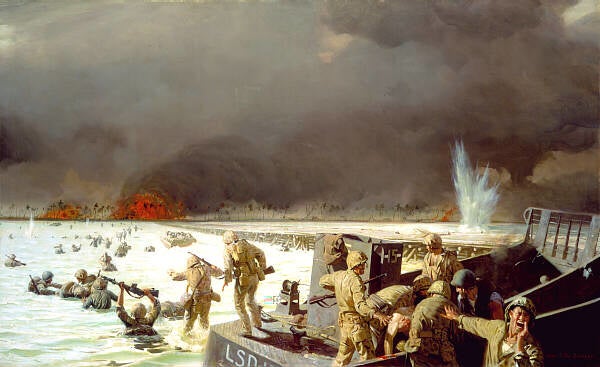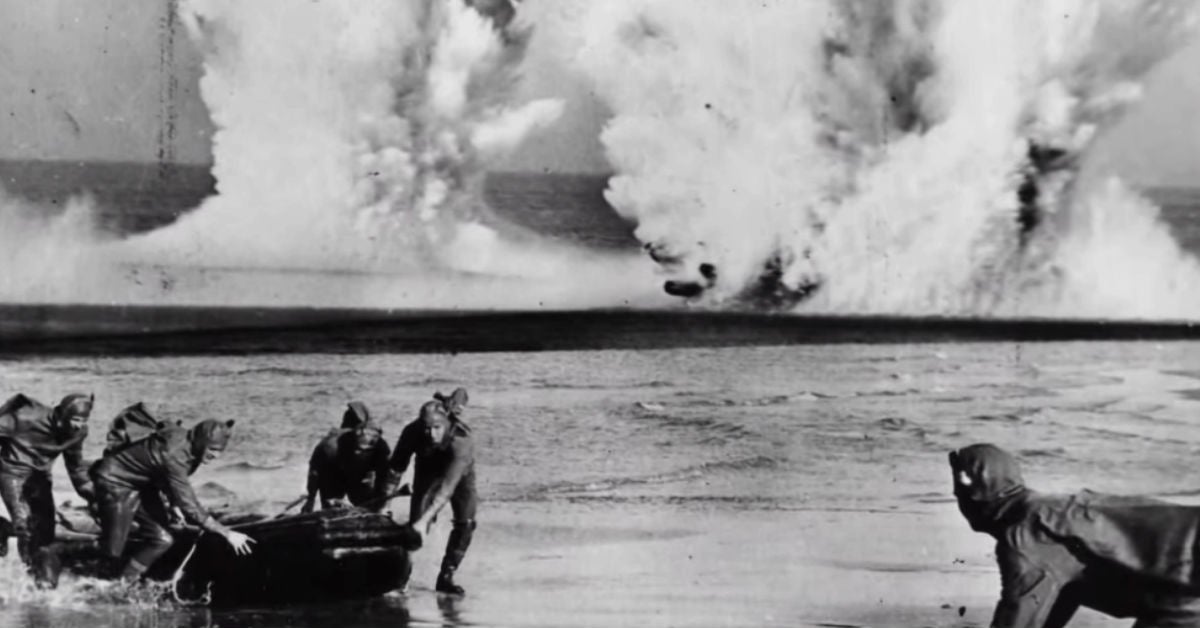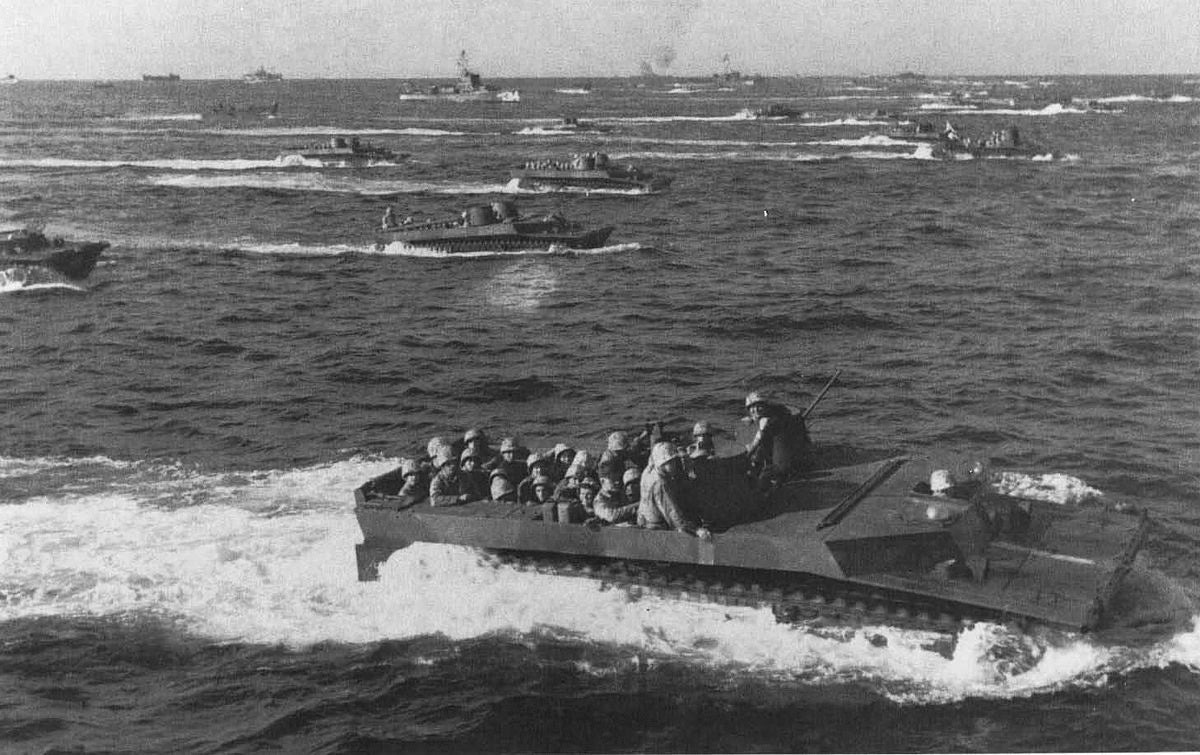D-Day US Navy Frogmen
Despite a limited number of submarines and other surveillance assets, naval forces in World War II had to find a way to spot enemy obstructions and defenses at fortified islands and beaches. Into the gap stepped the frogmen and recon swimmers, brave sailors and Marines who swam into enemy waters and surveyed defenses with just snorkels and fins, often with enemy fire raining around them. These "Frogmen" were to evolve into what we know now as the Navy Seals
On D-Day, these brave men played a critical role ensuring that landing craft could make it to shore and take part in one of the most daring, important assaults of World War II.
On D-Day, these brave men played a critical role ensuring that landing craft could make it to shore and take part in one of the most daring, important assaults of World War II.
Beach landings around the world, but especially the frequent landings in the Pacific during World War II, require good intelligence. Enemy mines and underwater obstacles can cripple a landing force when it’s most vulnerable. To ensure the landing works, attackers have to either avoid or clear such obstacles before the landings are affected.
The Navy learned this lesson the hard way when forces landing at Tarawa just hours after their arrival were forced to fight past a reef, beach obstacles and mines, and machine gun positions that had all been underestimated because no one got eyes directly on them before the fight. The invaders had relied on aerial imagery that couldn’t expose all the hazards. But when the Navy is short on stealthy assets, like submarines, someone else has to get up close and personal and see where the obstructions are.
“Frogmen,” recon swimmers whose efforts would lead to today’s Navy SEALs, filled this role by jumping out of small boats while wearing just shorts, snorkels, swim masks, and fins. From there, they had to swim along enemy beaches and make mental notes of anywhere they saw natural or man-made obstacles that could hinder a landing.
The Navy learned this lesson the hard way when forces landing at Tarawa just hours after their arrival were forced to fight past a reef, beach obstacles and mines, and machine gun positions that had all been underestimated because no one got eyes directly on them before the fight. The invaders had relied on aerial imagery that couldn’t expose all the hazards. But when the Navy is short on stealthy assets, like submarines, someone else has to get up close and personal and see where the obstructions are.
“Frogmen,” recon swimmers whose efforts would lead to today’s Navy SEALs, filled this role by jumping out of small boats while wearing just shorts, snorkels, swim masks, and fins. From there, they had to swim along enemy beaches and make mental notes of anywhere they saw natural or man-made obstacles that could hinder a landing.
If the obstacles were thick and foreboding enough, they had to destroy them, swimming up to mines and other countermeasures and dismantling them in place or blowing them up. Most frogmen served in units named for this task, the “Underwater Demolition Teams,” or UDTs.
Worse, if there was any question of the shore composition, the frogmen were tasked with swimming up to the beach itself, gathering sand, and swimming back with their samples.
While Iwo Jima was revealed to be largely bare of obstacles, the swimmers had to collect the volcanic ash of the beach as Japanese defenders in pillboxes were laying down a thick blanket of fire on the swimmers and their fire support ships. The hail of bullets was so thick that the ships frequently had to leave the line to put out fires and repair damage.
The swimmers had no such safe space. When they landed at Utah and Omaha beaches on D-Day, the Utah team suffered 17 casualties and the Omaha team lost 91 killed and wounded. 37 men died on the two beaches to reduce the threat to the follow-on attackers.
They had to sneak up to obstacles and place dozens of pounds of explosives on them to prepare them for destruction, sometimes while close enough to German patrols and sentries to hear them speaking to each other.
The frogmen avoided mortar and small-arms fire by ducking underwater as they swam into the beach. One diver’s account simply stated, “Bullets drifted down like falling leaves.” Amazingly, all but one of the divers returned safely.
Their sacrifices, while great, saved lives. Have a look at the video at the bottom to learn more about the frogmen on D-Day.
Worse, if there was any question of the shore composition, the frogmen were tasked with swimming up to the beach itself, gathering sand, and swimming back with their samples.
While Iwo Jima was revealed to be largely bare of obstacles, the swimmers had to collect the volcanic ash of the beach as Japanese defenders in pillboxes were laying down a thick blanket of fire on the swimmers and their fire support ships. The hail of bullets was so thick that the ships frequently had to leave the line to put out fires and repair damage.
The swimmers had no such safe space. When they landed at Utah and Omaha beaches on D-Day, the Utah team suffered 17 casualties and the Omaha team lost 91 killed and wounded. 37 men died on the two beaches to reduce the threat to the follow-on attackers.
They had to sneak up to obstacles and place dozens of pounds of explosives on them to prepare them for destruction, sometimes while close enough to German patrols and sentries to hear them speaking to each other.
The frogmen avoided mortar and small-arms fire by ducking underwater as they swam into the beach. One diver’s account simply stated, “Bullets drifted down like falling leaves.” Amazingly, all but one of the divers returned safely.
Their sacrifices, while great, saved lives. Have a look at the video at the bottom to learn more about the frogmen on D-Day.
Frogmen Demolition Team for D-Day Landing Prep
5 minutes in length
US Navy Film Promo on Frogmen Training
Made in 1957, this amazing U.S. Navy film showcases the pre-cursors to the SEALs, the UDTs or Underwater Demolition Teams. Underwater Demolition Teams (UDT) conducted beach reconnaissance, cable and net cutting, explosive destruction of underwater obstacles for amphibious landings, limpet mine attacks, submarine operations, and the locating and marking of mines for minesweepers. They also conducted river surveys and foreign military training. While doing this, the UDTs pioneered combat swimming, closed-circuit diving, underwater demolitions, and midget submarine (dry and wet submersible) operations. Many of these capabilities are shown in this film, which likely inspired Hollywood to create ""Sea Hunt"" and might have been fodder for Ian Fleming as well. An especially interesting segment shows UDTs deploying from a submerged GUPPY-class submarine, a strategy they famously employed during the Korean War to raid enemy railways.
28 minutes in length


